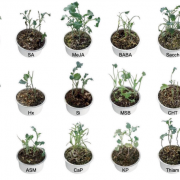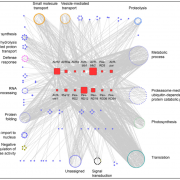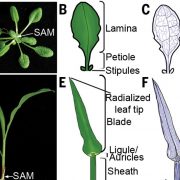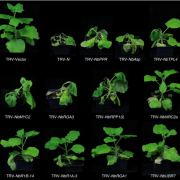CsIVP functions in vasculature development and downy mildew resistance in cucumber (PLOS Biol)
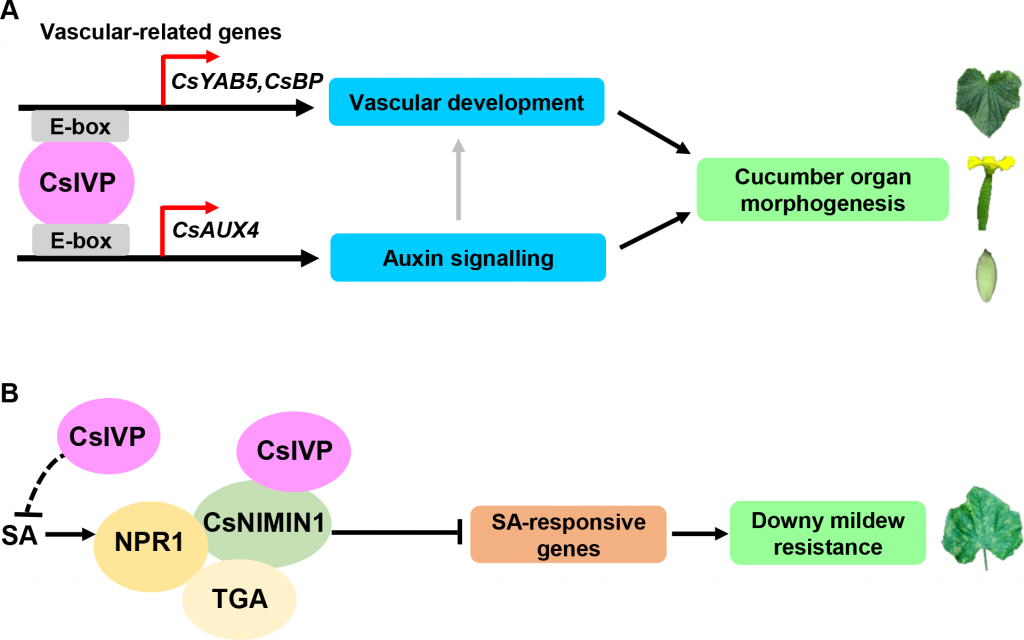 High yielding crops are often less resistant to pathogens and vice versa, suggesting that there is an underlying mechanism co-regulating development and disease resistance in plants. Yan et al. identified a transcription factor in cucumber (CsIVP) that regulates vascular development and resistance to downy mildew (caused by the oomycete pathogen Pseudoperonospora cubensis). CsIVP is highly expressed in the vascular tissues and localized in the nucleus. RNAi-mediated knockdown of CsIVP resulted in plants with compromised vascular development and accumulation of auxin in the leaf veins. RNA-seq analysis revealed that several known developmental regulators and auxin-related genes were significantly altered in CsIVP-RNAi compared to the wildtype plants. CsIVP bound E-box elements in the promoters of vascular related genes including CsYAB5. Knockdown of CsYAB5 mimics the phenotype of CsIVP suggesting that CsYAB5 functions downstream of CsIVP in regulating vascular development. CsIVP-RNAi lines were exceptionally resistant to greenhouse diseases thus suggesting the possible role of CsIVP in pathogen response. CsIVP-RNAi plants were specifically resistant to downy mildew, showing reduced lesions and absence of conidiophores compared to WT. Defense-related phytohormone genes were significantly enriched in CsIVP-RNAi. Indeed, salicylic acid (SA) was significantly increased in CsIVP-RNAi leaves. Taken together, CsIVP functions as a regulator of organ morphogenesis and resistance to down mildew through interactions with CsYAB5 and CsNIMIN1 respectively. (Summary by Toluwase Olukayode) PLOS Biol. 10.1371/journal.pbio.3000671
High yielding crops are often less resistant to pathogens and vice versa, suggesting that there is an underlying mechanism co-regulating development and disease resistance in plants. Yan et al. identified a transcription factor in cucumber (CsIVP) that regulates vascular development and resistance to downy mildew (caused by the oomycete pathogen Pseudoperonospora cubensis). CsIVP is highly expressed in the vascular tissues and localized in the nucleus. RNAi-mediated knockdown of CsIVP resulted in plants with compromised vascular development and accumulation of auxin in the leaf veins. RNA-seq analysis revealed that several known developmental regulators and auxin-related genes were significantly altered in CsIVP-RNAi compared to the wildtype plants. CsIVP bound E-box elements in the promoters of vascular related genes including CsYAB5. Knockdown of CsYAB5 mimics the phenotype of CsIVP suggesting that CsYAB5 functions downstream of CsIVP in regulating vascular development. CsIVP-RNAi lines were exceptionally resistant to greenhouse diseases thus suggesting the possible role of CsIVP in pathogen response. CsIVP-RNAi plants were specifically resistant to downy mildew, showing reduced lesions and absence of conidiophores compared to WT. Defense-related phytohormone genes were significantly enriched in CsIVP-RNAi. Indeed, salicylic acid (SA) was significantly increased in CsIVP-RNAi leaves. Taken together, CsIVP functions as a regulator of organ morphogenesis and resistance to down mildew through interactions with CsYAB5 and CsNIMIN1 respectively. (Summary by Toluwase Olukayode) PLOS Biol. 10.1371/journal.pbio.3000671
[altmetric doi=”10.1371/journal.pbio.3000671″ details=”right” float=”right”]


